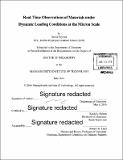| dc.contributor.advisor | David Veysset. | en_US |
| dc.contributor.author | Veysset, David (David Georges) | en_US |
| dc.contributor.other | Massachusetts Institute of Technology. Department of Chemistry. | en_US |
| dc.date.accessioned | 2016-09-30T19:36:21Z | |
| dc.date.available | 2016-09-30T19:36:21Z | |
| dc.date.copyright | 2016 | en_US |
| dc.date.issued | 2016 | en_US |
| dc.identifier.uri | http://hdl.handle.net/1721.1/104573 | |
| dc.description | Thesis: Ph. D., Massachusetts Institute of Technology, Department of Chemistry, 2016. | en_US |
| dc.description | Cataloged from PDF version of thesis. Page 171 blank. | en_US |
| dc.description | Includes bibliographical references (pages [151]-170). | en_US |
| dc.description.abstract | New methods are introduced for direct real-time observations of materials under dynamic loading. Traditionally, converging shock waves, which are of great interest for studying fundamental aspects of behavior of materials under extreme conditions, have been studied on the spatial scale ~1 m using facilities such as implosion chambers. In this work, direct real-time visualization of converging shock waves in a thin liquid layer was demonstrated at the micron scale in an all-optical experiment. Shock waves were generated in a 10 [mu]m-thick layer of water by sub-nanosecond laser pulses focused into a ring of 100 [mu]m radius. Time-resolved interferometry imaging with a femtosecond probe pulse was used to obtain full-field images at variable delays tracing the converging shock wave as it collapsed at the focal point leading to the formation of a cavitation bubble. Pressure values calculated from velocity measurements agreed with those obtained from quantitative analysis of interferometric images. Other samples were investigated using the same experimental setup. Focusing surface waves leading to material damage were observed on a glass substrate and conversion from highly-ordered pyrolytic graphite to nano-crystalline carbon was demonstrated under shock conditions. The developed technique will enable shock-induced chemical reactions to be investigated with direct access to the shocked reacting material for spectroscopic tools in a small-scale all-optical experiment. A novel approach for hypervelocity impact testing of materials using microprojectiles and a table-top laser system was also developed in this work. Microparticles were placed on a transparent substrate coated with a laser-absorbing polymer layer. Ablation of the polymer by a short laser pulse accelerated the particles to high velocities (~1 km/s). The impact events of high-speed particles with target material surfaces were monitored using an ultrafast multi-frame camera. In particular, the impact response of poly(urethane urea) (PUU) elastomers was investigated in order to further the understanding of the molecular influence on the dynamical behavior of PUUs. The results will provide an impetus for modeling microscale impact responses and high-strain rate deformation for a large spectrum of materials ranging from viscoelastic polymers and gels to elastic-plastic metals. | en_US |
| dc.description.statementofresponsibility | by David Veysset. | en_US |
| dc.format.extent | 171 pages | en_US |
| dc.language.iso | eng | en_US |
| dc.publisher | Massachusetts Institute of Technology | en_US |
| dc.rights | M.I.T. theses are protected by copyright. They may be viewed from this source for any purpose, but reproduction or distribution in any format is prohibited without written permission. See provided URL for inquiries about permission. | en_US |
| dc.rights.uri | http://dspace.mit.edu/handle/1721.1/7582 | en_US |
| dc.subject | Chemistry. | en_US |
| dc.title | Real-time observations of materials under dynamic loading conditions at the micron scale | en_US |
| dc.type | Thesis | en_US |
| dc.description.degree | Ph. D. | en_US |
| dc.contributor.department | Massachusetts Institute of Technology. Department of Chemistry | |
| dc.identifier.oclc | 958669263 | en_US |
